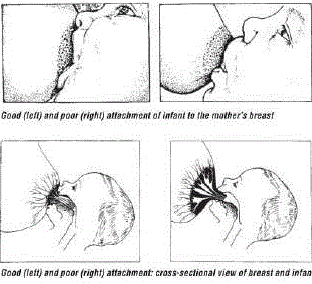
Benefits of breastfeeding - babies who are exclusively breastfed for 6 months will get the greatest health benefits and disease prevention.
Colostrum (first yellowish milk after delivery)– this will meet the needs of the baby in the first few days after birth.
Discomfort for the mother at the start of breast feeds in the first few days is not uncommon, but this should not persist.
A baby may have a variable feeding pattern, at least over the first few days, as the baby takes small amounts of colostrum and then takes increasingly larger feeds as the milk supply comes in.
When the milk supply is established, a baby will generally feed every 2–3 hours, but this will vary between babies and, if the baby is healthy, his/ her individual pattern should be respected.
Empty both breasts at each feed.
Ask mother if the infant has breastfed in the previous hour?
If infant has not fed in the previous hour, ask the mother to put her infant to the breast and assess for the following:
Observe the breastfeed for 4 minutes
Signs of good positioning:
Baby’s body is well supported.Signs of good attachment:
Chin touching breast
Mouth wide open
Lower lip turned outward
More areola above than below the mouth
Effective sucking is when the infant shows slow deep sucks, sometimes pausing.
If not sucking well, then look for ulcers or white patches in the mouth (thrush).
Key facts for providers and mothers/ guardians - Breast feeding
|
If signs and symptoms of mastitis persist more than several hours the mother should contact her
healthcare provider and may require antibiotic treatment.
If the baby is not taking sufficient milk directly from the breast and supplementary feeds are necessary,
expressed breast milk should be given by a cup or spoon (Supplementation not recommended).